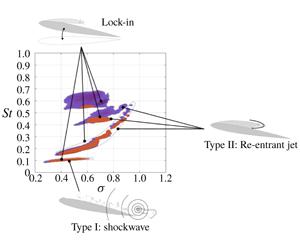Journal of Fluid Mechanics ( IF 3.7 ) Pub Date : 2020-06-17 , DOI: 10.1017/jfm.2020.323 Samuel M. Smith , James A. Venning , Bryce W. Pearce , Yin Lu Young , Paul A. Brandner

|
The influence of fluid–structure interaction on cloud cavitation about a hydrofoil is investigated by comparing results from a relatively stiff reference hydrofoil, presented in Part 1, with those obtained on a geometrically identical flexible hydrofoil. Measurements were conducted with a chord-based Reynolds number  $Re=0.8\times 10^{6}$
for cavitation numbers,
$Re=0.8\times 10^{6}$
for cavitation numbers,  $\unicode[STIX]{x1D70E}$
, ranging from 0.2 to 1.2 while the hydrofoil was mounted at an incidence,
$\unicode[STIX]{x1D70E}$
, ranging from 0.2 to 1.2 while the hydrofoil was mounted at an incidence,  $\unicode[STIX]{x1D6FC}$
, of
$\unicode[STIX]{x1D6FC}$
, of  $6^{\circ }$
to the oncoming flow. Tip deformations and cavitation behaviour were recorded with synchronised force measurements utilising two high-speed cameras. The flexible composite hydrofoil was manufactured as a carbon/glass-epoxy hybrid structure with a lay-up sequence selected principally to consider spanwise bending deformations with no material-induced bend–twist coupling. Hydrodynamic bend–twist coupling is seen to result in nose-up twist deformations causing frequency modulation from the increase in cavity length. The lock-in phenomenon driven by re-entrant jet shedding observed on the stiff hydrofoil is also evident on the flexible hydrofoil at
$6^{\circ }$
to the oncoming flow. Tip deformations and cavitation behaviour were recorded with synchronised force measurements utilising two high-speed cameras. The flexible composite hydrofoil was manufactured as a carbon/glass-epoxy hybrid structure with a lay-up sequence selected principally to consider spanwise bending deformations with no material-induced bend–twist coupling. Hydrodynamic bend–twist coupling is seen to result in nose-up twist deformations causing frequency modulation from the increase in cavity length. The lock-in phenomenon driven by re-entrant jet shedding observed on the stiff hydrofoil is also evident on the flexible hydrofoil at  $0.70\leqslant \unicode[STIX]{x1D70E}\leqslant 0.75$
, but occurs between different modes. Flexibility is observed to accelerate cavitation regime transition with reducing
$0.70\leqslant \unicode[STIX]{x1D70E}\leqslant 0.75$
, but occurs between different modes. Flexibility is observed to accelerate cavitation regime transition with reducing  $\unicode[STIX]{x1D70E}$
. This is seen with the rapid growth and influence the shockwave instability has on the forces, deflections and cavitation behaviour on the flexible hydrofoil, suggesting structural behaviour plays a significant role in modifying cavity physics. The reduced stiffness causes secondary lock-in of the flexible hydrofoil’s one-quarter sub-harmonic,
$\unicode[STIX]{x1D70E}$
. This is seen with the rapid growth and influence the shockwave instability has on the forces, deflections and cavitation behaviour on the flexible hydrofoil, suggesting structural behaviour plays a significant role in modifying cavity physics. The reduced stiffness causes secondary lock-in of the flexible hydrofoil’s one-quarter sub-harmonic,  $f_{n}/4$
, at
$f_{n}/4$
, at  $\unicode[STIX]{x1D70E}$
= 0.4. This leads to the most severe deflections observed in the conditions tested along with a shift in phase between normal force and tip deflection.
$\unicode[STIX]{x1D70E}$
= 0.4. This leads to the most severe deflections observed in the conditions tested along with a shift in phase between normal force and tip deflection.
中文翻译:

流体-结构相互作用对柔性翼型云空化的影响。第2部分。
通过比较第1部分中给出的相对刚性参考水翼的结果与在几何上相同的柔性水翼上获得的结果,研究了流固耦合对水翼形云空化的影响。使用基于弦的雷诺数
$ Re = 0.8 \乘以10 ^ {6} $
进行的气蚀数
$ \ unicode [STIX] {x1D70E} $进行测量
,范围从0.2到1.2,而水翼安装在入射位置,
$ \ unicode [STIX] {x1D6FC} $
,
$ 6 ^ {\ circ} $



 迎面而来的流程。使用两个高速相机通过同步力测量来记录尖端变形和气蚀行为。柔性复合材料水翼被制成碳/玻璃-环氧树脂混合结构,其层叠顺序主要是考虑到翼展方向弯曲变形而没有材料引起的弯曲-扭转耦合。流体动力弯曲-扭曲耦合被认为会导致机头向上扭曲变形,从而由于腔体长度的增加而引起频率调制。在刚性水翼上观察到的折返喷流驱动的锁定现象在柔性水翼上也很明显,为
$ 0.70 \ leqslant \ unicode [STIX] {x1D70E} \ leqslant 0.75 $
迎面而来的流程。使用两个高速相机通过同步力测量来记录尖端变形和气蚀行为。柔性复合材料水翼被制成碳/玻璃-环氧树脂混合结构,其层叠顺序主要是考虑到翼展方向弯曲变形而没有材料引起的弯曲-扭转耦合。流体动力弯曲-扭曲耦合被认为会导致机头向上扭曲变形,从而由于腔体长度的增加而引起频率调制。在刚性水翼上观察到的折返喷流驱动的锁定现象在柔性水翼上也很明显,为
$ 0.70 \ leqslant \ unicode [STIX] {x1D70E} \ leqslant 0.75 $
 ,但发生在不同的模式之间。观察到灵活性可以通过减少
$ \ unicode [STIX] {x1D70E} $
来加速空化状态转换。可以看出,这是快速增长的,并且冲击波不稳定性对柔性水翼上的力,挠度和空化行为有影响,这表明结构行为在改变型腔物理学中起着重要作用。降低的刚度会导致柔性水翼艇的四分之一子谐波
$ f_ {n} / 4 $
二次锁定,其值为
$ \ unicode [STIX] {x1D70E} $
= 0.4。这会导致在测试条件下观察到的最严重的挠度,以及法向力和尖端挠度之间的相移。
,但发生在不同的模式之间。观察到灵活性可以通过减少
$ \ unicode [STIX] {x1D70E} $
来加速空化状态转换。可以看出,这是快速增长的,并且冲击波不稳定性对柔性水翼上的力,挠度和空化行为有影响,这表明结构行为在改变型腔物理学中起着重要作用。降低的刚度会导致柔性水翼艇的四分之一子谐波
$ f_ {n} / 4 $
二次锁定,其值为
$ \ unicode [STIX] {x1D70E} $
= 0.4。这会导致在测试条件下观察到的最严重的挠度,以及法向力和尖端挠度之间的相移。




























 京公网安备 11010802027423号
京公网安备 11010802027423号